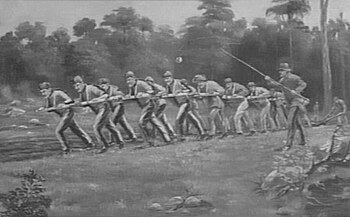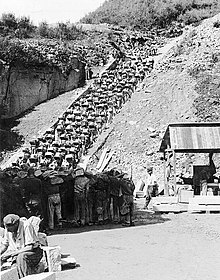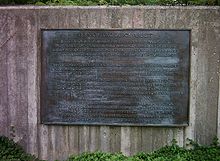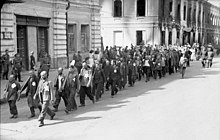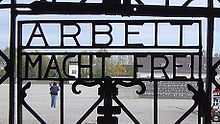
As part of the Russian invasion of Ukraine, the Russian state and state-controlled media have spread disinformation in an information war. Russian propaganda and fake news stories have attacked Ukraine's right to exist and accused it of being a neo-Nazi state, of committing genocide against Russian speakers, of developing nuclear and biological weapons, and of being influenced by Satanism. Russian propaganda also accuses NATO of controlling Ukraine and building up military infrastructure in Ukraine to threaten Russia. Some of this disinformation has been spread by Russian web brigades. It has been widely rejected as untrue and crafted to justify the invasion and even to justify genocidal acts against Ukrainians. The Russian state has denied carrying out war crimes in Ukraine, and Russian media has falsely blamed some of them on Ukrainian forces instead. Some of the disinformation seeks to undermine international support for Ukraine and to provoke hostility against Ukrainian refugees.
Russian disinformation has been pervasive and successful in Russia itself, due to censorship of war news and state control of most media. Because of the amount of disinformation, Russian media has been restricted and its reputation has been tarnished in many Western and developed countries. However, the Russian state has had more success spreading its views in many developing countries. In particular, Chinese state media has been very sympathetic to the Russian side, and has repeatedly censored war news or reproduced Russian fake news and disinformation.
Ukrainian media and politicians have also been accused of using propaganda stories and deception as a part of the military campaign, although such efforts have been much more limited than Russia's disinformation campaign.
Russian themes
Disinformation (a lie or exaggeration meant to sway opinion) has been spread by the Russian state, state-controlled media, propagandists, and Russian web brigades as part of Russia's invasion of Ukraine. Its purpose is to build support for Russia's invasion, and to weaken opposition to the invasion. It also seeks to sow disunity among Western countries who support Ukraine; to counter NATO; and to cover up or create plausible deniability for Russian war crimes.
The following are common themes in Russian propaganda and disinformation, along with some of the common rebuttals.
Denying Ukrainian nationhood and statehood
Russian propaganda has targeted Ukrainian nationhood and national identity, portraying Ukrainians as "Little Russians" or "part of an all-Russian nation". This has been a theme in Russian imperialist and nationalist rhetoric since the seventeenth century. For years, Russian president Vladimir Putin has questioned the Ukrainian people's identity and the country's legitimacy and spread conspiratorial views of Ukrainian national identity as an "anti-Russian project" in his 2021 essay "On the Historical Unity of Russians and Ukrainians".
After the 2014 Ukrainian Revolution, Russian rhetoric portrayed Ukrainian governments as illegitimate, calling them the "Kyiv regime" or a "Nazi/fascist junta". Putin said they were "led by a band of drug addicts and neo-Nazis", and claimed Ukraine is "under external control" by the West or the United States.
Such denial of nationhood is said to be part of a campaign of incitement to genocide by Russian state authorities.
Allegations of Nazism
Putin falsely claimed that the Ukrainian government were neo-Nazis and announced that one of his goals was the "de-Nazification of Ukraine". Putin's claims were repeated by Russian foreign minister Sergey Lavrov in a speech to the UN Human Rights Council; many diplomats walked out in protest. These claims were repeated in Russian media to justify the war. In April 2022, Russian state-owned news agency RIA Novosti published an article by Timofey Sergeytsev, "What Russia should do with Ukraine", where he argued that Ukraine and Ukrainian national identity must be wiped out, because he claimed most Ukrainians are at least "passive Nazis". By May, references to "denazifying" Ukraine in Russian media began to wane, reportedly because it had not gained traction with the Russian public.
These allegations of Nazism are widely rejected as untrue and part of a Russian disinformation campaign to justify the invasion, with many pointing out that Ukrainian President Volodymyr Zelenskyy is Jewish and had relatives who were victims of the Holocaust. Some of the world's leading historians of Nazism and the Holocaust put out a statement rejecting Putin's claims, which was signed by hundreds of other historians and scholars of the subject. It says:
"We strongly reject the Russian government's ... equation of the Ukrainian state with the Nazi regime to justify its unprovoked aggression. This rhetoric is factually wrong, morally repugnant and deeply offensive to the memory of millions of victims of Nazism and those who courageously fought against it".
The authors say that Ukraine "has right-wing extremists and violent xenophobic groups" like any country, but "none of this justifies the Russian aggression and the gross mischaracterization of Ukraine". The Auschwitz-Birkenau State Museum denounced Putin's claims, saying "once again, innocent people are being killed purely because of insane pseudo-imperial megalomania". The US Holocaust Memorial Museum and Yad Vashem condemned Putin's abuse of Holocaust history. Ukrainian Jews likewise rejected claims of Ukraine being a neo-Nazi state.
Kremlin claims of Nazism against Ukraine are partly an attempt to drum-up support for the war among its citizens. Russian propaganda has framed it as a continuation of the Soviet Union's "Great Patriotic War" against Nazi Germany, "even as Russia supports extreme-right groups across Europe". The Washington Post commented that "the rhetoric of the 'fight against fascism' resonates deeply in Russia, which suffered huge losses in the fight against Nazi Germany". As part of this propaganda drive, Ukrainian flags have been replaced with Victory Banners in some occupied towns and cities.
Experts on disinformation say that portraying Ukrainians as Nazis helps Russians justify war crimes against them; Russia's UN representative justified the Hroza missile attack in this way. Historian Timothy Snyder said the Russian regime calls Ukrainians "Nazis" to justify genocidal acts against them. He said pro-war Russians use the word "Nazi" to mean "a Ukrainian who refuses to be Russian". Russian neo-fascist Aleksandr Dugin proposed to simply "identify Ukrainian Nazism with Russophobia". Dugin argued that Russia should be the only country allowed to define "Ukrainian Nazism" and "Russophobia", in the same way that Jews have a "monopoly" on the definition of antisemitism.
Ukraine, like many countries, has a far-right fringe such as the Svoboda party. Ukraine's Azov Brigade, which had far-right origins, was a focus of Kremlin propaganda and this spread into Western media. However, by the time of the invasion, sources say that the brigade had been de-politicized. Analysts say the Russian government greatly exaggerates far-right influence in Ukraine: there is no widespread support for far-right ideology in the government, military, or electorate. In the 2019 Ukrainian parliamentary election, a coalition of far-right parties received only 2% of votes and did not win any seats.
Ukrainian officials respond that Russia's own actions in Ukraine are like those of Nazi Germany, and some commentators have likened Putin's Russia to a fascist state (see Ruscism). Some Russian units who took part in the invasion are themselves linked to neo-Nazism, such as the Rusich Group and Wagner Group. Russian far-right groups also played an major role among the Russian proxy forces in Donbas.
Allegations of "genocide" in Donbas

In his announcement of the invasion, Russian president Vladimir Putin baselessly claimed that Ukraine was carrying out genocide in the mainly Russian-speaking Donbas region. He said the purpose of Russia's "military operation" was to "protect the people" of the Russian-controlled breakaway republics of Donetsk and Luhansk. Putin claimed they had been facing "genocide perpetrated by the Kyiv regime" for eight years. There is no evidence for Putin's claims of genocide, and they have been widely rejected as an excuse to justify invasion. The European Commission called the allegations "Russian disinformation". Over 300 scholars on genocide issued a statement rejecting Russia's abuse of the term "genocide" to "justify its own violence". Ukraine brought a case before the International Court of Justice (ICJ) to challenge Russia's claim. The ICJ said it had not seen any evidence of genocide by Ukraine.
Altogether, about 14,300 people were killed in the Donbas War, both soldiers and civilians. According to the Office of the United Nations High Commissioner for Human Rights, 6,500 were Russian proxy forces, 4,400 were Ukrainian forces, and 3,404 were civilians on both sides of the frontline. The vast majority of civilian deaths were in the first year, and the death rate in the Donbas War was actually falling before the 2022 Russian invasion: in 2019 there were 27 conflict-related civilian deaths, in 2020 there were 26 deaths, and in 2021 there were 25 deaths, over half of them from mines and unexploded ordnance. By comparison, after Russian full-scale invasion, 4,163 civilians were killed in March 2022, meaning that more civilians died in that one month alone than in the entire 8-years of the War in Donbas. Since the invasion, Russian state-controlled media and pro-Kremlin Telegram channels falsely accused Ukrainian troops of attacking civilian targets in Mariupol and bombing Ukrainian cities.
Allegations of NATO aggression

Russian propaganda often claims that NATO provoked the invasion and that Russia was forced to invade Ukraine to defend itself from NATO. In his speech announcing the invasion, Putin falsely claimed that NATO military infrastructure was being built up inside Ukraine and was a threat to Russia. Ukraine is not a NATO member, but Putin claimed that Ukraine is under NATO control. After the invasion began, Russian state media falsely claimed that some military units fighting for Ukraine were under NATO command, and that thousands of NATO soldiers had been killed. The Russian government has accused NATO of waging a "proxy war" against Russia, because its member states sent military aid to Ukraine after the invasion.
NATO is a collective security alliance of 31 member states, similar to the CSTO that Russia is a member of. Outside its member states, NATO only has a military presence in Kosovo and Iraq, at the request of their governments. In 2002, Putin said Ukraine's relationship with NATO was not Russia's concern, and NATO and Russia had co-operated until Russia annexed Crimea. NATO says it is not at war with Russia; its official policy is that it does not seek confrontation, but rather supports Ukraine in "its right to self-defense, as enshrined in the UN Charter". Lawrence Freedman writes that calling Ukraine a NATO "proxy" wrongly implies that "Ukrainians are only fighting because NATO put them up to it, rather than because of the more obvious reason that they have been subjected to a vicious invasion". He says that defeating Russia's invasion may prevent further Russian expansionism, which "is a bonus for NATO", but any weakening of Russia would be a result of "Moscow's folly ...not NATO's intent". Geraint Hughes argues that accusing Ukraine of being NATO's "proxy" insults and belittles Ukrainians; it denies their autonomy and implies they do not really have the will to defend their country.
Putin claimed that NATO broke a promise not to let any Eastern European countries join. This unwritten promise was allegedly made to Soviet leader Mikhail Gorbachev in 1990, but this was denied by both NATO and Gorbachev. Between the dissolution of the Soviet Union and the Russian invasion, 14 Eastern European countries willingly joined NATO, and the last time a country bordering Russia had joined NATO was in 2004. Ukraine has sought NATO membership since Russia began its military intervention in 2014, and it applied to join NATO following the 2022 invasion. According to Politico, members of the alliance have been wary of discussing Ukraine's potential membership due to "Putin's hyper-sensitivity" on the issue. Russia's Security Council warned that Ukraine joining NATO would spark a Third World War.
Russia's invasion also prompted Finland to join NATO, doubling the length of Russia's border with NATO. Unlike Ukraine, Putin said that Finland joining NATO was not a threat, "but the expansion of military infrastructure into this territory would certainly provoke our response".
Shortly before his death in a plane crash, Russian oligarch Yevgeny Prigozhin accused the Russian military leadership of lying about NATO aggression to justify the invasion. Prigozhin was a close ally of Putin and his Wagner Group played an important role in the Russian invasion. Peter Dickinson of the Atlantic Council suggested the real reason Putin opposes NATO is because it "prevents him from bullying Russia's neighbors".
Alleged assassination and sabotage attempts
On 18 February 2022, the Luhansk People's Republic showed a video appearing to show the removal of a car full of explosives that had been prepared for blowing up a train full of women and children evacuating to Russia. The video's metadata showed that it had been recorded on 12 June 2019.
The breakaway Donetsk People's Republic also released a video on 18 February 2022 that claimed to show Poles trying to blow up a chlorine tank. The video was distributed further by Russian media. The video's metadata showed that it was created on 8 February 2022, and included a mix of different pieces of audio or video, including a 2010 YouTube video from a military firing range in Finland. Ukrainian intelligence attributed responsibility for the video to the Russian intelligence service GRU.
According to Bellingcat, a supposed bombing of a "separatist police chief" by a "Ukrainian spy", broadcast on Russian state television, showed visual evidence of the bombing of an old "green army vehicle". The old car's registration plate was that of the separatist police chief, but the same licence plate was also seen on a different, new SUV. Ukraine accused Ukraine of a "terrorist attack" which killed three civilians in a car on the Donetsk-Gorlovka highway. France 24 described the incident as a false flag attempt with corpses likely coming from a morgue to set up the scene.
Russia's alleged attempt to end the Donbas War
On 7 September 2022, at the Eastern Economic Forum, Russian President Putin claimed that Russia did not "start" any military operations, but was only trying to end those that started in 2014, after a "coup d’état in Ukraine".
Before Russia began its full-scale invasion of Ukraine in 2022, the intensity of the hostilities in the Donbas had been steadily declining since the signing of the Minsk agreements in February 2015.
Ukrainian biological and radiological weapons
Biological weapons labs
In March 2022, Russia made unsubstantiated allegations that Ukraine was developing biological weapons in a network of labs linked to the US. The Ministry of Foreign Affairs of the People's Republic of China and Chinese state media amplified Russian claims. QAnon promoters were also echoing the disinformation. BBC Reality Check found no evidence supporting the claims. The United Nations also refuted the claim. Russian biologists in and outside of Russia have debunked the claims, stating that the allegations are "transparently false".
According to researcher Adam Rawnsley, the Kremlin has a history of discrediting ordinary biology labs in former Soviet republics, having previously spread conspiracy theories about Georgia and Kazakhstan similar to the accusations deployed against Ukraine.
Birds as bio-weapons
Prior to March 2022, the Russian Ministry of Defense had made unsubstantiated accusations that the United States was manufacturing bio-weapons in Ukraine. In March, the Ministry followed up with another conspiracy theory, which claims that the U.S. is training birds in Ukraine to spread disease among Russian citizens, according to a statement given by Major General Igor Konashenkov, spokesman of the Ministry to Russian state-controlled media. Specific details were given about diseases involved, including the name of a specific strain of flu with 50% mortality, as well as Newcastle disease. Media reports included maps, documents, and photos of birds with American military insignia, and also claimed that live, infected birds had been captured in eastern Ukraine.
The claims were laughed off by U.S. State Department spokesman, who called them "outright lies", "total nonsense", "absurd", "laughable" and "propaganda". Director of the CIA William Burns told the U.S. Senate that Russia was using such claims to prepare the terrain for a biological or chemical attack by Russian forces against Ukraine, which they would then blame on the United States and Ukraine.
Combat mosquitoes
On 28 October 2022, Vasily Nebenzya, the Permanent Representative of Russia to the United Nations, accused Ukraine of using drones with "combat mosquitoes" which spread "dangerous viruses". Andrii Yermak, the Head of the Office of the President of Ukraine, laughed off these accusations.
Ukrainian plans to use a dirty bomb
In March 2022, Russian state-controlled news agencies claimed, without evidence, that Ukraine was developing a plutonium-based dirty bomb nuclear weapon at the Chernobyl Nuclear Power Plant.
In a series of calls to foreign defense officials made in October 2022, Russian Minister of Defence Sergei Shoigu similarly claimed that Ukraine was preparing a "provocation" involving the use of a dirty bomb. The Institute for the Study of War suggested a desire to slow or suspend foreign aid to Ukraine as a possible motive for the allegations. The foreign ministries of France, the United Kingdom and the United States rejected "Russia's transparently false allegations". In a briefing, the Russian Ministry of Defence used photos of the Beloyarsk Nuclear Power Station, the Novosibirsk Chemical Concentrates Plant, the aftermath of the September 11 attacks, and a photo from a 2010 presentation by the Slovenian Radioactive Waste Management Agency as "evidence" for its claims.
Denial of Russian war crimes
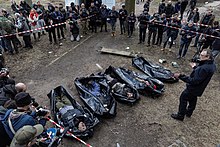
During the Russian invasion of Ukraine, numerous war crimes and crimes against humanity were recorded and extensively documented, including attacks on civilians and energy-related infrastructure, wilful killings, unlawful confinement, torture, rape, unlawful transfers and deportations of children, and others. Despite this, Russian officials denied all of the war crimes perpetrated by the Russian forces. Russian Foreign Minister Sergey Lavrov called the Bucha massacre a "fake attack" used against Russia, claiming it had been staged. He said that Russian forces had left Bucha on 30 March while evidence of killings had emerged, according to him, four days later.
On 4 April, at the United Nations, the Russian representative Vasily Nebenzya said that the bodies in the videos were not there before the Russian forces withdrew from Bucha. This was contradicted by satellite images which showed that the bodies were there as early as 19 March; the position of the corpses in the satellite images match the smartphone photos taken in early April.
The Russian Defence Ministry's Telegram channel reposted a report stating Russian forces had not targeted civilians during the battle. According to the statement, a massacre could not have been covered up by the Russian military, and the mass grave in the city was filled with victims of Ukrainian airstrikes. The Ministry said it had analyzed a video purporting to show the bodies of dead civilians in Bucha, and said the corpses filmed were moving. This claim was investigated by the BBC's Moscow Department, which concluded there was no evidence the video had been staged. During the Mariupol theatre airstrike, Russian officials blamed Ukrainian forces of bombing themselves, though independent sources confirmed that Russia was responsible.

In November 2022, Putin's spokesman Dmitry Peskov denied that the Russian military was attacking civilian infrastructure in Ukraine. According to Peskov, the Russian army only attacks targets that are directly or indirectly connected to military potential. In January 2023, the Russian Ministry of Defence confirmed their responsibility for the Dnipro residential building airstrike, which killed over 40 civilians. However, Peskov stated that Russian forces never attack residential buildings and that the residential building had probably collapsed because of a Ukrainian air defense counterattack.
In December 2022, Russian opposition politician Ilya Yashin was sentenced to eight-and-a-half years in prison for his statements about the circumstances of the killings in Bucha on charges of "spreading false information" about the armed forces. Yashin was tried over a YouTube video released in April 2022 in which he discussed the discovery of murdered Ukrainian civilians in the suburban town of Bucha, near Kyiv. In February 2023, Russian journalist Maria Ponomarenko was sentenced to six years in prison for publishing information about the Mariupol theatre airstrike.
Other Russian claims
Ukrainian Satanism and black magic
In May 2022, as the invasion continued, Russian state media claimed that Ukraine was using black magic to fend off the Russian military. RIA Novosti claimed that evidence of black magic had been found in an eastern Ukrainian village; according to their report, Ukrainian soldiers had allegedly consecrated their weapons "with blood magick" at a location with a "satanic seal".
Dmitry Medvedev, deputy chairman of Russia's Security Council and former Russian president and prime minister, described the invasion as a sacred war against Satan. Vladimir Solovyov, a presenter on state-owned channel Russia-1, has also called the invasion a "holy war" against "Satanists" and said Russia is up against fifty countries that are "united by Satanism".
Assistant secretary of Russia's Security Council, Aleksey Pavlov, called for the "de-Satanization" of Ukraine in October 2022, claiming that the country had turned into a "totalitarian hypersect". In an article for the Russian state-owned Argumenty i Fakty newspaper, he identified the Chabad-Lubavitch Hasidic Jewish movement as one of the "hundreds of neo-pagan cults" operating in Ukraine. Russia's chief rabbi, Berel Lazar, wrote a letter to Russian authorities, asking them to condemn Pavlov's comments, which he described as "a new variety of old blood libels". About 70% of Ukrainians are religious, and half of those attend religious services.
False flag fakes
In March 2022, videos were discovered purporting to show Ukrainian-produced disinformation about missile strikes inside Ukraine which were then "debunked" as some other event outside Ukraine. However, this may be the first case of a disinformation false-flag operation, as the original, supposedly "Ukraine-produced" disinformation was never disseminated by anyone, and was in fact preventive disinformation created specifically to be debunked and cause confusion and mitigate the impact on the Russian public of real footage of Russian strikes within Ukraine that may get past Russian-controlled media. According to Patrick Warren, head of Clemson's Media Forensics Hub, "It's like Russians actually pretending to be Ukrainians spreading disinformation. ... The reason that it's so effective is because you don't actually have to convince someone that it's true. It's sufficient to make people uncertain as to what they should trust."
The Olenivka prison massacre, described by most independent experts as a Russian-orchestrated sabotage, has been reported by Russian media as a missile attack by Ukraine. While the exact cause of the incident has still not been conclusively confirmed, most experts conclude the Russian version highly improbable.
Flight and surrender of Ukrainian President
The Russian state media agency TASS claimed that Zelenskyy fled Kyiv following the invasion and also that he had surrendered. Zelenskyy used social media to post statements, videos and photos to counter the Russian disinformation.
Russian state-owned television channel Russia-1 spread false claims that Volodymyr Zelenskyy fled Ukraine following the 10 October 2022 missile strikes.
Anti-refugee sentiments
Russian disinformation has also attempted to promote anti-refugee sentiments in Poland and other countries dealing with the influx of mostly Ukrainian refugees from the war. Social media accounts identified as having ties to Russia have promoted stories including claims of refugees committing crimes or being unfairly privileged, or about locals discriminating against refugees (in particular, against black and non-Ukrainian refugees). Such disinformation is intended to weaken international support for Ukraine.
News masquerading as Western coverage
During the crisis, a number of fabricated CNN headlines and stories went viral on social media. Misinformation spread on social media included a faked image of CNN reporting that Steven Seagal had been seen alongside the Russian military, false tweets claiming that a CNN journalist had been killed in Ukraine, a CNN lower third that was digitally altered to include a claim that Putin had issued a statement warning India not to interfere in the conflict, and another that was altered to claim that Putin planned to delay the 2022 Russian invasion of Ukraine until "Biden delivers weapons to Ukraine for Russia to capture", as well as a fabricated CNN tweet supposedly reporting on a figure referred to as "the Kharkiv Kid finder" alongside an image that actually portrayed the YouTuber Vaush, who resides in the US and was not in Kharkiv at the time.
In addition to fake news with CNN logo, other Western stations have had similar fakes distributed, for example BBC or DW.
"Grandmother with red flag"

A video showing an elderly woman holding a Soviet flag to greet the Ukrainian military has been widely spread in Runet since March 2022. The grandmother with a red flag was turned into an iconic image by Russian propaganda. Allegedly, it represents the desire of "ordinary Ukrainians" to reunite with their "Russian brothers".
Anna Ivanovna, the subject of the "grandmother with red flag" video, explained that she mistook the Ukrainian military for Russian invaders and she wanted to "placate" them with a red Bolshevik flag so they would not destroy the village. She now regrets it and feels like a "traitor". Her house near Kharkiv was destroyed by the Russian army, and she and her husband have been evacuated. She cursed the Russian army which she deemed was responsible for shelling her house. The Ukrainian military appealed to the public to not chastise Ivanovna, who was a victim herself.
Claims Wikipedia is publishing false information
Amongst Russia's attempts to control the free press and present their own views, are Russian attacks on Wikipedia which has been on a government registry of prohibited websites for over 10 years. In May 2022, the Wikimedia Foundation was fined 5 million rubles for articles about the Russian invasion of Ukraine. Russia claimed to have uncovered 16.6 million messages spreading “fakes” about the invasion on platforms including Wikipedia. In November 2022 a Russian court fined Wikimedia Foundation 2 million rubles for not deleting "false" information in seven articles about the "special military operation", including the Bucha massacre and the Mariupol theatre airstrike. In April 2023 another fine of 800,000 rubles was imposed on the Wikimedia Foundation for not removing materials about Russian rock band Psiheya and another fine of 2 million rubles was imposed in relations to other articles such as the Russian language version of Russian occupation of Zaporizhzhia Oblast.
Claim of peace treaty signed in March 2022
In June 2023 Putin showed South African President Cyril Ramaphosa, amongst others, a document which he claimed was a signed peace treaty made in March 2022 in Istanbul in Turkey. A peace treaty that Ukraine then broke. No such treaty was signed, peace negotiations were held but were abandoned. On 7 April 2022, Russian Foreign Minister Sergei Lavrov announced that a draft peace deal from Ukraine had been rejected as it contained “unacceptable” elements that deviated from proposals that both sides’ negotiators had earlier agreed on.
Ukrainian themes
The Ghost of Kyiv
On the second day of the 2022 Russian invasion of Ukraine, videos and picture went viral on social media, with claims that a Ukrainian pilot nicknamed the "Ghost of Kyiv" had shot down 6 Russian fighter jets in the first 30 hours of the war. However, there have been no credible evidence that he existed. A video of the alleged pilot was shared on Facebook and the official Twitter account of the Ukrainian Ministry of Defence, was later found to be from the video game Digital Combat Simulator World. An altered photo was also shared by the former president of Ukraine, Petro Poroshenko. On 30 April 2022, Ukrainian Air Force asked the "Ukrainian community not to neglect the basic rules of information hygiene" and to "check the sources of information, before spreading it", stating that the Ghost of Kyiv "embodies the collective spirit of the highly qualified pilots of the Tactical Aviation Brigade who are successfully defending Kyiv and the region".
Other disinformation
Turkish mercenaries
In October 2022, a video had been gaining traction on social media allegedly showing Turkish mercenaries going to fight for Russia in the Ukraine war. The video was first published by a pro-Russian Telegram channel claiming that "Turkish legionnaires joined the Russian army and will take part in combat operations in Ukraine". But it quickly gained traction when Nexta shared it with a similar claim. However journalists from Euronews Turkish-language service confirmed that the men are speaking a dialect of Turkish but are not from Turkey. The mix between this dialect and some Russian words signals that these men were most likely Meskhetian Turks (Ahiska Turks). Euronews spoke to a representative of Ahiska Turks abroad who confirmed that the men in the video are speaking the Ahiska dialect. He also told that he believes that these men living in Russia and therefore being mobilised for the war in Ukraine. Adding that, since Ahiska Turks consider themselves Turkish, this is why the soldiers were seen with a Turkish flag in the video.
Russosphere
Russosphere is a French-language social network that promotes pro-Russian propaganda in Africa. It was created in 2021, but fully launched in February 2022, prior to the invasion of Ukraine. It amassed over 65,000 followers on social media platforms such as Facebook, YouTube and Twitter, as well as Telegram and VK. The network's posts typically accuse France of modern-day "colonialism", describe the Ukrainian army as "Nazis" and "Satanists", and praise the Wagner Group, a Russian private military company. In early 2023, the BBC and Logically reported that Russosphere was created by Luc Michel, a Belgian far-right activist.
Russian mobilization
On 22 September 2022, the "conscript base" of the 2022 Russian mobilization from the hacker group Anonymous began to spread in Ukrainian Telegram channels. As it was claimed, the distributed file allegedly contained the passport data of more than 305 thousand Russians subject to mobilization "first of all." It was also noted that Anonymous hackers obtained the data by hacking the website of the Ministry of Defense of the Russia, but the group itself didn't report this leak. The Ministry of Defense of the Russia didn't comment on the alleged leak, but reposted "War on Fakes", a Telegram channel. The report says that the published database "is compiled from several open databases and has nothing to do with the Ministry of Defense." Ruslan Leviev, the founder of Conflict Intelligence Team, and Andrei Zakharov, a correspondent of the BBC News Russian, are of the opinion that the "conscript base" is a fake.
Fake RAND report
In September 2022, the Swedish far-right online newspaper Nya Dagbladet published a document it claimed was leaked from the RAND Corporation, a U.S.-based think tank. The report, which was supposedly published that January, claimed the U.S. planned the Russian invasion of Ukraine and the subsequent energy crisis to weaken Germany and divide Europe. Nya Dagbladet's article was shared by Russian state media outlet RT and the Russian Embassy in Sweden on Twitter.
RAND denied publishing such a report, stating that it was a fake. Lead Stories noted that the document's content resembled statements by members of the far-right QAnon conspiracy theory movement. Logically noted that the report contained many issues indicating it was a fake, including multiple factual, spelling, grammatical and formatting errors, and several discrepancies with RAND's other published reports.
Release of unproven intelligence
United States officials said they had intelligence suggesting that Russia might be preparing to use chemical weapons in Ukraine, a claim that US President Joe Biden later echoed publicly. However, in April 2022, three U.S. officials told NBC News that there is no evidence of Russia bringing chemical weapons near to Ukraine, and that the intelligence was released to deter Russia from using chemical weapons.
U.S. officials had said that Russia had turned to China for potential military assistance, a claim one European official and two U.S. officials told NBC lacked hard evidence. U.S. officials said that the Biden administration made this allegation to discourage China from actually providing assistance to Russia.
Censorship
In Russia
On 4 March 2022, President Putin signed into law a bill introducing prison sentences of up to 15 years for those who publish "knowingly false information" about the Russian military and its operations, with the Russian government deciding what is the truth, leading to some media outlets in Russia to stop reporting on Ukraine or shutting their media outlet. Although the 1993 Russian Constitution has an article expressly prohibiting censorship, the Russian censorship apparatus Roskomnadzor ordered the country's media to only use information from Russian state sources or face fines and blocks, and accused a number of independent media outlets of spreading "unreliable socially significant untrue information" about the shelling of Ukrainian cities by the Russian army and civilian deaths.
Roskomnadzor launched an investigation against the Novaya Gazeta, Echo of Moscow, inoSMI, MediaZona, New Times, TV Rain, and other independent Russian media outlets for publishing "inaccurate information about the shelling of Ukrainian cities and civilian casualties in Ukraine as a result of the actions of the Russian Army". On 1 March 2022, the Russian government blocked access to TV Rain, as well as Echo of Moscow, in response to their coverage of the invasion of Ukraine by Russian forces. The channel closed, with its general director announcing they would be "temporarily halting its operations", on 3 March 2022.
As of December 2022, more than 4,000 people were prosecuted under "fake news" laws in connection with the war in Ukraine. Hugh Williamson, Europe and Central Asia director at Human Rights Watch, said that "These new laws are part of Russia’s ruthless effort to suppress all dissent and make sure the [Russian] population does not have access to any information that contradicts the Kremlin’s narrative about the invasion of Ukraine."
Due to Russian fake news laws, Russian authorities blocked Facebook and Twitter, while TikTok in Russia banned new uploads. However a study by Tracking Exposed found out that TikTok had blocked all non-Russian content, but has continued to host old videos uploaded by Russia-based accounts and permitted Russian state media to continue posting, described as establishing a "splinternet" within a global social media platform. TikTok's vague censorship has permitted pro-Kremlin news but blocked foreign accounts and critics of the war, as a result "Russians are left with a frozen TikTok, dominated by pro-war content".
In China
The BBC reported that coverage of the war was heavily censored on social media in China. Many stories and accounts supporting one or the other side were removed. A Taiwanese research group accused Chinese media of "regularly quoting disinformation and conspiracy theories from Russian sources".
In March 2022, China Global Television Network (CGTN) paid for digital ads on Facebook targeting users with newscasts featuring pro-Kremlin talking points after Meta Platforms banned Russian state media advertisements. The same month, CGTN repeated unsubstantiated Russian claims of biological weapons labs in Ukraine. A leaked internal directive from Beijing News ordered its employees not to publish news reports that were "negative about Russia". An analysis found that nearly half of Weibo's social media posts used Russia sources which were pro-Putin or described Ukraine in negative terms, while another third of posts were anti-West and blamed NATO, while very few posts described the war in neutral terms. Several history professors have penned an open letter that strongly opposed China's support for "Russia's war against Ukraine" but their post was quickly deleted by censors, while a celebrity who criticized Russia over the invasion had her account suspended.
Effects of Russian disinformation
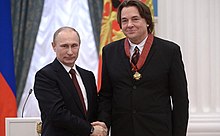
Facebook uncovered a Russian campaign using fake accounts, and attempts to hack the accounts of high-profile Ukrainians. There are reports of Russian government staff searching for "organic content" posted by genuine users in support of the Kremlin, while making sure that these do not run afoul of platform guidelines, then amplifying these posts. Researchers have found that Russia's Internet Research Agency has operated numerous troll farms who spam critics of the Kremlin with pro-Putin and pro-war comments.
In February 2022, Eliot Higgins of Bellingcat judged that the quality of Russian misinformation videos had weakened, but remained especially effective for the older generation of Russians.
Some observers noted what they described as a "generational struggle" among Russians over perception of the war, with younger Russians often opposed to the war and older Russians more likely to accept the narrative presented by state-controlled mass media in Russia. Kataryna Wolczuk, an associate fellow of Chatham House's Russia and Eurasia programme, said that "[Older] Russians are inclined to think in line with the official 'narrative' that Russia is defending Russian speakers in Ukraine, so it's about offering protection rather than aggression." About two-thirds of Russians use television as their primary source of daily news. According to the cyber threat intelligence company Miburo, about 85% of Russians get most of their news from Russian state-controlled media.
Many Ukrainians say that their relatives and friends in Russia trust what the state-controlled media tells them and refuse to believe that there is a war in Ukraine and that the Russian army is shelling Ukrainian cities.
Some Western commentators have claimed that the main reason many Russians have supported Putin and the "special military operation" in Ukraine has to do with the propaganda and disinformation. At the end of March, a poll conducted in Russia by the Levada Center concluded the following: When asked why they think the military operation is taking place, respondents said it was to protect and defend civilians, ethnic Russians or Russian speakers in Ukraine (43%), to prevent an attack on Russia (25%), to get rid of nationalists and "denazify" Ukraine (21%), and to incorporate Ukraine and/or the Donbas region into Russia (3%)."
In China, India, Indonesia, Malaysia, Africa, the Arab world, and Latin America, some social media users trended towards showing sympathy for Russian narratives. A study performed by Airlangga University revealed that 71% of Indonesian netizens supported the invasion. This support was due to affection for Putin's strongman leadership, as well as anti-US and anti-Western political alignments. Additionally, many Indonesians supported Russia due to positive reports of Ramzan Kadyrov and claims of the Azov Battalion covering their bullets with lard to be used against Chechen troops in the invasion.
A series of four online polls by Alexei Navalny's Anti-Corruption Foundation found that between 25 February and 3 March, the share of respondents in Moscow who considered Russia an "aggressor" increased from 29% to 53%, while the share of those who considered Russia a "peacemaker" fell by half from 25% to 12%. On 5 April 2022, Alexei Navalny said the "monstrosity of lies" in the Russian state media "is unimaginable. And, unfortunately, so is its persuasiveness for those who have no access to alternative information." He tweeted that "warmongers" among Russian state media personalities "should be treated as war criminals. From the editors-in-chief to the talk show hosts to the news editors, [they] should be sanctioned now and tried someday."
Countering Russian disinformation

The United States Department of State and the European External Action Service of the European Union (EU) published guides aiming to respond to Russian disinformation. Twitter paused all ad campaigns in Ukraine and Russia in an attempt to curb misinformation spread by ads. European Commission president Ursula von der Leyen announced an EU-wide ban of Russian state-sponsored RT and Sputnik news channels on 27 February, after Poland and Estonia had done so days before.
Reddit, an American social news aggregation, content rating, and discussion website, quarantined subreddits r/Russia, the national subreddit of Russia, and r/GenZedong, a self-described "Dengist" subreddit in March 2022, after both the subreddits were spreading Russian disinformation. In the case of r/Russia, the site's administrators removed one of the moderators, for spreading disinformation. Sister sub of r/Russia, r/RussiaPolitics was also quarantined for similar reasons. When the subreddits are quarantined, they don't show up in searches, recommendations and user feeds, and anyone who tries to access the quarantined subreddits would be shown a warning regarding the content, which they must acknowledge in order to access it.
In May 2022 a group calling themselves NAFO was created with the object of posting irreverent commentary about the war and memes promoting Ukraine or mocking the Russian war effort and strategy using a "cartoon dog" based on the Shiba Inu. NAFO was seen by The Washington Post as having significant effects against Russian troll farms. On 28 August 2022, the official Twitter account of the Ministry of Defense of Ukraine tweeted its appreciation of NAFO, with an image of missiles being fired and a "Fella" dressed in a combat uniform, hands on face, in a posture of appreciation.




